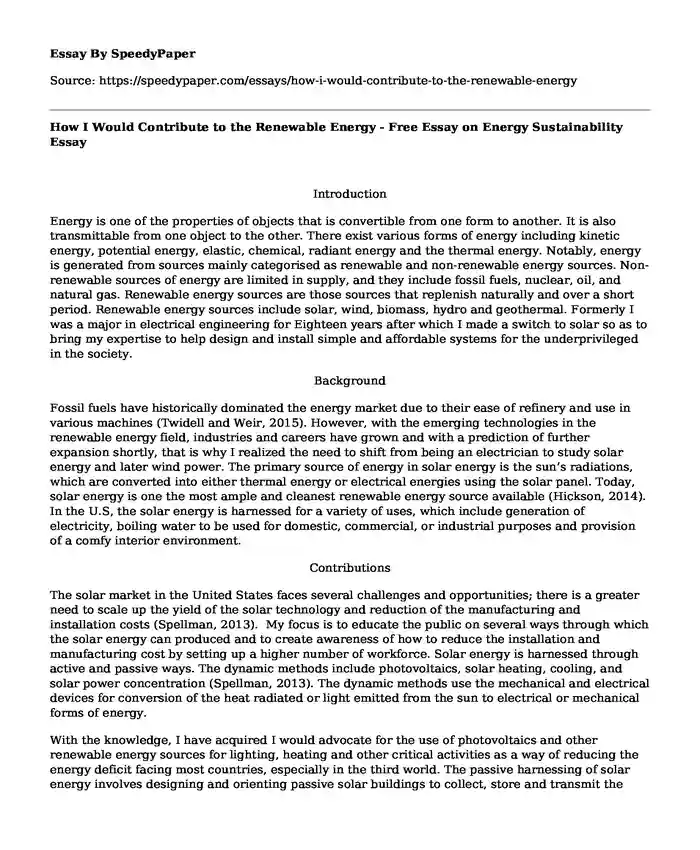
| Type of paper: | Essay |
| Categories: | Economics Environment Energy |
| Pages: | 3 |
| Wordcount: | 706 words |
Introduction
Energy is one of the properties of objects that is convertible from one form to another. It is also transmittable from one object to the other. There exist various forms of energy including kinetic energy, potential energy, elastic, chemical, radiant energy and the thermal energy. Notably, energy is generated from sources mainly categorised as renewable and non-renewable energy sources. Non-renewable sources of energy are limited in supply, and they include fossil fuels, nuclear, oil, and natural gas. Renewable energy sources are those sources that replenish naturally and over a short period. Renewable energy sources include solar, wind, biomass, hydro and geothermal. Formerly I was a major in electrical engineering for Eighteen years after which I made a switch to solar so as to bring my expertise to help design and install simple and affordable systems for the underprivileged in the society.
Background
Fossil fuels have historically dominated the energy market due to their ease of refinery and use in various machines (Twidell and Weir, 2015). However, with the emerging technologies in the renewable energy field, industries and careers have grown and with a prediction of further expansion shortly, that is why I realized the need to shift from being an electrician to study solar energy and later wind power. The primary source of energy in solar energy is the sun’s radiations, which are converted into either thermal energy or electrical energies using the solar panel. Today, solar energy is one the most ample and cleanest renewable energy source available (Hickson, 2014). In the U.S, the solar energy is harnessed for a variety of uses, which include generation of electricity, boiling water to be used for domestic, commercial, or industrial purposes and provision of a comfy interior environment.
Contributions
The solar market in the United States faces several challenges and opportunities; there is a greater need to scale up the yield of the solar technology and reduction of the manufacturing and installation costs (Spellman, 2013). My focus is to educate the public on several ways through which the solar energy can produced and to create awareness of how to reduce the installation and manufacturing cost by setting up a higher number of workforce. Solar energy is harnessed through active and passive ways. The dynamic methods include photovoltaics, solar heating, cooling, and solar power concentration (Spellman, 2013). The dynamic methods use the mechanical and electrical devices for conversion of the heat radiated or light emitted from the sun to electrical or mechanical forms of energy.
With the knowledge, I have acquired I would advocate for the use of photovoltaics and other renewable energy sources for lighting, heating and other critical activities as a way of reducing the energy deficit facing most countries, especially in the third world. The passive harnessing of solar energy involves designing and orienting passive solar buildings to collect, store and transmit the heat energy radiated from the sun to maintain the comfort of occupants without the use of moving parts or electronics. I intend to use my proficiency as a solar energy engineer to volunteer in modelling after Grid Alternative which will provide solar energy to the poor communities especially Africa.
Conclusion
There is a fundamental need to harness the renewable energy at this age, which is very sensitive to the environmental effects of using the nonrenewable sources like the fossil fuels, and sustainability is an ethical norm. My focus today is on both adequacy of energy supply long-term and the implication of environment of particular sources more so to the third world countries. Impose the costs imposed on carbon dioxide emissions in developed countries, which has changed the economic outlook to the third world countries. The renewable sources of energy, which are abundant and ongoing, have not been entirely used except for hydro and solar which is majorly used in agriculture and forestry thus the need to educate the public on the benefits of using the renewable sources over nonrenewable sources.
References
Twidell, J., & Weir, T. (2015). Renewable energy resources. New York: Routledge, Taylor & Francis Group.
Spellman, F. R. (2013). Water & wastewater infrastructure: Energy efficiency and sustainability. Boca Raton, FL: CRC Press, Taylor & Francis.
Hickson, K. (2014). Race for sustainability: Energy, economy, environment and ethics. New Jersey: World Scientific
Cite this page
How I Would Contribute to the Renewable Energy - Free Essay on Energy Sustainability. (2017, Sep 27). Retrieved from https://speedypaper.net/essays/how-i-would-contribute-to-the-renewable-energy
Request Removal
If you are the original author of this essay and no longer wish to have it published on the SpeedyPaper website, please click below to request its removal:
- Role of Globalization in Education in China, Essay Example
- Essay Example with a Reflection Paper about an Article
- Free Essay with an Article Review Example
- Free Essay about Cultural Sensitivity and Health Care
- Economics Essay Example: Loanable Funds and Money Creation in Banks
- Essay Sample on Recruitment and Selection Plan for Benefits Manager
- Paper Example. History of Japan and the Cold War
Popular categories




